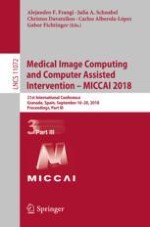2018 | OriginalPaper | Buchkapitel
Registration-Free Infant Cortical Surface Parcellation Using Deep Convolutional Neural Networks
verfasst von : Zhengwang Wu, Gang Li, Li Wang, Feng Shi, Weili Lin, John H. Gilmore, Dinggang Shen
Erschienen in: Medical Image Computing and Computer Assisted Intervention – MICCAI 2018
Aktivieren Sie unsere intelligente Suche, um passende Fachinhalte oder Patente zu finden.
Wählen Sie Textabschnitte aus um mit Künstlicher Intelligenz passenden Patente zu finden. powered by
Markieren Sie Textabschnitte, um KI-gestützt weitere passende Inhalte zu finden. powered by
